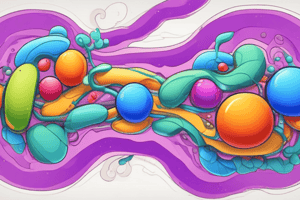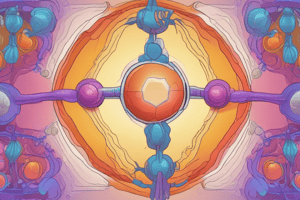Podcast
Questions and Answers
What is the role of NADH in biochemical reactions?
What is the role of NADH in biochemical reactions?
- It solely facilitates the synthesis of RNA.
- It serves as a hydride donor in oxidation-reduction reactions. (correct)
- It is a byproduct of aerobic respiration.
- It acts as a primary substrate for energy production.
Which of the following statements about NADP+/NADPH is correct?
Which of the following statements about NADP+/NADPH is correct?
- NADP+ differs from NAD+ by having an esterified phosphate. (correct)
- NADPH only exists in the oxidized state.
- Both NADP+ and NAD+ can donate electrons equally.
- NADPH is primarily involved in catabolic pathways.
How many electrons and protons are accepted by the nicotinamide ring to form NADH?
How many electrons and protons are accepted by the nicotinamide ring to form NADH?
- 1 electron and 1 proton.
- 2 protons and no electrons.
- 3 electrons only.
- 2 electrons and 1 proton. (correct)
What compound does the reduction of NAD+ produce along with the acceptance of electrons?
What compound does the reduction of NAD+ produce along with the acceptance of electrons?
Which of the following accurately describes the electron transfer reaction for NAD+?
Which of the following accurately describes the electron transfer reaction for NAD+?
How many ATP molecules are produced from one glucose molecule during cellular respiration?
How many ATP molecules are produced from one glucose molecule during cellular respiration?
What role does NADH play in the regulation of the TCA cycle?
What role does NADH play in the regulation of the TCA cycle?
Which molecule provides feedback inhibition on phosphofructokinase, affecting glycolysis?
Which molecule provides feedback inhibition on phosphofructokinase, affecting glycolysis?
Where is the electron transport chain located in the cell?
Where is the electron transport chain located in the cell?
What is the process called when ATP is synthesized from the energy released by the oxidation of hydrogen carriers?
What is the process called when ATP is synthesized from the energy released by the oxidation of hydrogen carriers?
What is the primary function of ATP in cells?
What is the primary function of ATP in cells?
What process weakens and breaks the last phosphate bond in ATP?
What process weakens and breaks the last phosphate bond in ATP?
How do cells continuously generate ATP?
How do cells continuously generate ATP?
What is the estimated number of ATP molecules generated and consumed by a single cell per second?
What is the estimated number of ATP molecules generated and consumed by a single cell per second?
What type of reaction is the hydrolysis of ATP categorized as?
What type of reaction is the hydrolysis of ATP categorized as?
What is the primary function of anabolic pathways in metabolism?
What is the primary function of anabolic pathways in metabolism?
What is released during the endergonic process of dehydration synthesis involving ADP?
What is released during the endergonic process of dehydration synthesis involving ADP?
Which of the following describes catabolic pathways?
Which of the following describes catabolic pathways?
Which molecule acts as an electron acceptor in catabolic pathways?
Which molecule acts as an electron acceptor in catabolic pathways?
What type of reaction occurs during photosynthesis?
What type of reaction occurs during photosynthesis?
What type of bond in ATP contains the most energy?
What type of bond in ATP contains the most energy?
What is the role of ATP in cellular metabolism?
What is the role of ATP in cellular metabolism?
Which process represents an exergonic reaction?
Which process represents an exergonic reaction?
What is the significance of the Citric Acid Cycle in cellular metabolism?
What is the significance of the Citric Acid Cycle in cellular metabolism?
What distinguishes endergonic reactions from exergonic reactions?
What distinguishes endergonic reactions from exergonic reactions?
Which of the following describes potential energy in the context of bioenergetics?
Which of the following describes potential energy in the context of bioenergetics?
What is the primary role of FAD in biochemical reactions?
What is the primary role of FAD in biochemical reactions?
What distinguishes NAD+ from FAD?
What distinguishes NAD+ from FAD?
During one turn of the citric acid cycle, how many molecules of NADH are produced?
During one turn of the citric acid cycle, how many molecules of NADH are produced?
What is the net output of carbon dioxide from one triboxylic cycle?
What is the net output of carbon dioxide from one triboxylic cycle?
Which statement is true regarding the function of FAD?
Which statement is true regarding the function of FAD?
Where are the enzymes of the citric acid cycle located?
Where are the enzymes of the citric acid cycle located?
How does the dimethylisoalloxazine ring function in FAD?
How does the dimethylisoalloxazine ring function in FAD?
What is the general flow of substrates in the mitochondria during the citric acid cycle?
What is the general flow of substrates in the mitochondria during the citric acid cycle?
Flashcards
What is Bioenergetics?
What is Bioenergetics?
The study of how energy is used and transformed in living organisms.
What is Kinetic Energy?
What is Kinetic Energy?
Energy associated with motion. Examples include heat and light.
What is Potential Energy?
What is Potential Energy?
Energy stored in an object's position or state. Examples include chemical bonds.
What are Endergonic Reactions?
What are Endergonic Reactions?
Signup and view all the flashcards
What are Exergonic Reactions?
What are Exergonic Reactions?
Signup and view all the flashcards
What is Metabolism?
What is Metabolism?
Signup and view all the flashcards
What are Anabolic Pathways?
What are Anabolic Pathways?
Signup and view all the flashcards
What are Catabolic Pathways?
What are Catabolic Pathways?
Signup and view all the flashcards
Ribose
Ribose
Signup and view all the flashcards
Phosphate Group (ATP)
Phosphate Group (ATP)
Signup and view all the flashcards
Phosphorylation
Phosphorylation
Signup and view all the flashcards
ATP-ase
ATP-ase
Signup and view all the flashcards
Adenosine Triphosphate (ATP)
Adenosine Triphosphate (ATP)
Signup and view all the flashcards
Coupled Reaction
Coupled Reaction
Signup and view all the flashcards
Hydrolysis of ATP
Hydrolysis of ATP
Signup and view all the flashcards
Dehydration of ATP
Dehydration of ATP
Signup and view all the flashcards
What is NAD+ and its role in metabolism?
What is NAD+ and its role in metabolism?
Signup and view all the flashcards
What is NADP+ and how does it differ from NAD+?
What is NADP+ and how does it differ from NAD+?
Signup and view all the flashcards
Summarize the electron transfer between NAD+ and NADH.
Summarize the electron transfer between NAD+ and NADH.
Signup and view all the flashcards
Why are NAD+ and NADH important in metabolism?
Why are NAD+ and NADH important in metabolism?
Signup and view all the flashcards
FADH₂
FADH₂
Signup and view all the flashcards
GTP
GTP
Signup and view all the flashcards
The Krebs cycle
The Krebs cycle
Signup and view all the flashcards
Electron Transport Chain (ETC)
Electron Transport Chain (ETC)
Signup and view all the flashcards
Oxidative phosphorylation
Oxidative phosphorylation
Signup and view all the flashcards
What is NAD+?
What is NAD+?
Signup and view all the flashcards
What is FAD?
What is FAD?
Signup and view all the flashcards
What is NADH?
What is NADH?
Signup and view all the flashcards
What is FADH2?
What is FADH2?
Signup and view all the flashcards
What is the mitochondria?
What is the mitochondria?
Signup and view all the flashcards
What is the Citric Acid Cycle?
What is the Citric Acid Cycle?
Signup and view all the flashcards
What is ATP?
What is ATP?
Signup and view all the flashcards
What is glycolysis?
What is glycolysis?
Signup and view all the flashcards
Study Notes
Bioenergetics Overview
- Bioenergetics is the study of energy in living systems and the role of organisms (plants and animals) that utilize them.
- Energy is essential for all organisms. This energy can be either kinetic or potential.
Energy Types
- Kinetic energy is the energy of motion. Examples include heat and light energy.
- Potential energy is the energy of position. This includes energy stored within chemical bonds.
Types of Energy Reactions
- Endergonic reactions require a net input of energy. An example of an endergonic reaction is photosynthesis, where light energy is used to convert carbon dioxide and water into glucose and oxygen. The equation is 6CO₂ + 6H₂O → C₆H₁₂O₆ + 6O₂
- Exergonic reactions release energy. An example of an exergonic reaction is cellular respiration, where glucose and oxygen are used to produce carbon dioxide, water, and ATP. The equation is C₆H₁₂O₆ + 6O₂ → 6CO₂ + 6H₂O + ATP
Metabolism
- Metabolism is the sum of all chemical activities of all cells.
- Anabolic pathways consume energy to build complex molecules from simpler molecules. Photosynthesis is an example.
- Catabolic pathways release energy breaking down complex molecules into simpler molecules. Cellular respiration is an example.
ATP (Adenosine Triphosphate)
- ATP is the primary energy currency of cells.
- ATP is composed of adenine, ribose (a five-carbon sugar), and three phosphate groups.
- The high-energy bonds between the phosphate groups store a large amount of energy.
- Cells continually break down and rebuild ATP.
ATP Breakdown
- ATP is broken down by a process called hydrolysis releasing energy and the phosphate group PO₄.
- The enzyme ATPase weakens and breaks the bond between the last phosphate group (PO₄) and the rest of the ATP molecule.
- ATP is the form which cells store energy produced from breaking down energy rich glucose.
ATP Usage
- Approximately 10,000,000 molecules of ATP are generated and then consumed per second by each cell.
Coupled Reaction
- ATP hydrolysis (exergonic reaction) powers endergonic reactions by transferring a phosphate group to another molecule, providing the energy.
Hydrolysis of ATP
- ATP + H₂O → ADP + P (exergonic)
- Hydrolysis releases substantial energy.
ATP - Dehydration
- ADP + P → ATP + H₂O (endergonic)
- Dehydration stores energy.
NAD+/NADH
- NAD+ is an electron carrier in catabolic pathways, accepting two electrons and a proton to form NADH.
- NADH is important in electron transport and energy release.
- NADP+/NADPH is similar to NAD+, but differs in one phosphate group. NADPH is an electron donor in synthetic pathways.
FAD/FADH2
- FAD (Flavin adenine dinucleotide) is another electron carrier, derived from the vitamin riboflavin.
- FAD accepts two electrons and two protons to form FADH2 for energy release
Coenzyme vs Prosthetic group
- NAD+ is a coenzyme, it reversibly (temporarily) binds to enzymes.
- FAD is a prosthetic group, it permanently binds to enzymes and stays attached during reactions.
Cellular Respiration Process
- Glucose → Pyruvic acid (Glycolysis) → Krebs Cycle → Electron Transport Chain
- 2 ATP from glycolysis - 36 ATP from ETC
TCA Cycle (Tri carboxylic acid cycle)
- The citric acid cycle is a metabolic cycle that occurs in the inner matrix of the mitochondria.
- Each turn of the citric acid cycle produces two molecules of carbon dioxide, three molecules of NADH, one FADH₂, one GTP, and three H+ ions.
- A single glucose molecule produces double the output of the TCA cycle's net output (because two molecules of pyruvate are produced from a single molecule of glucose and the two molecules of pyruvate make two acetyl coAs and then enter the cycle)
- The citric acid cycle is regulated by metabolites (products of the cycle) providing negative feedback to enzymes in the cycle.
ETC (Electron Transport Chain)
- ETC is on the inner mitochondrial membrane (Cristae).
- High energy electrons are transferred through proteins (complex I-IV) across the membrane.
- This process creates a proton motive force (PMF), and this force drives the synthesis of ATP. This is Oxidative phosphorylation.
- Oxygen is the final acceptor of electrons
ATP per glucose molecule
- One glucose molecule is metabolized to yield 38 ATP molecules during cellular respiration.
- The electron transport system produces 34 molecules of ATP out of a total of 38 molecules.
Regulation of TCA Cycle
- The TCA cycle is regulated in several ways, including through negative feedback loops involving pathway products.
- Citrate, for example, inhibits the enzyme phosphofructokinase, which is involved in glycolysis.
- Calcium also stimulates the TCA cycle.
Studying That Suits You
Use AI to generate personalized quizzes and flashcards to suit your learning preferences.
Related Documents
Description
This quiz explores the crucial roles of NADH and NADPH in biochemical reactions, the electron transport chain, and ATP synthesis. Questions cover the processes involved in cellular respiration and how energy is generated in cells. Test your knowledge on these key biochemical concepts!





